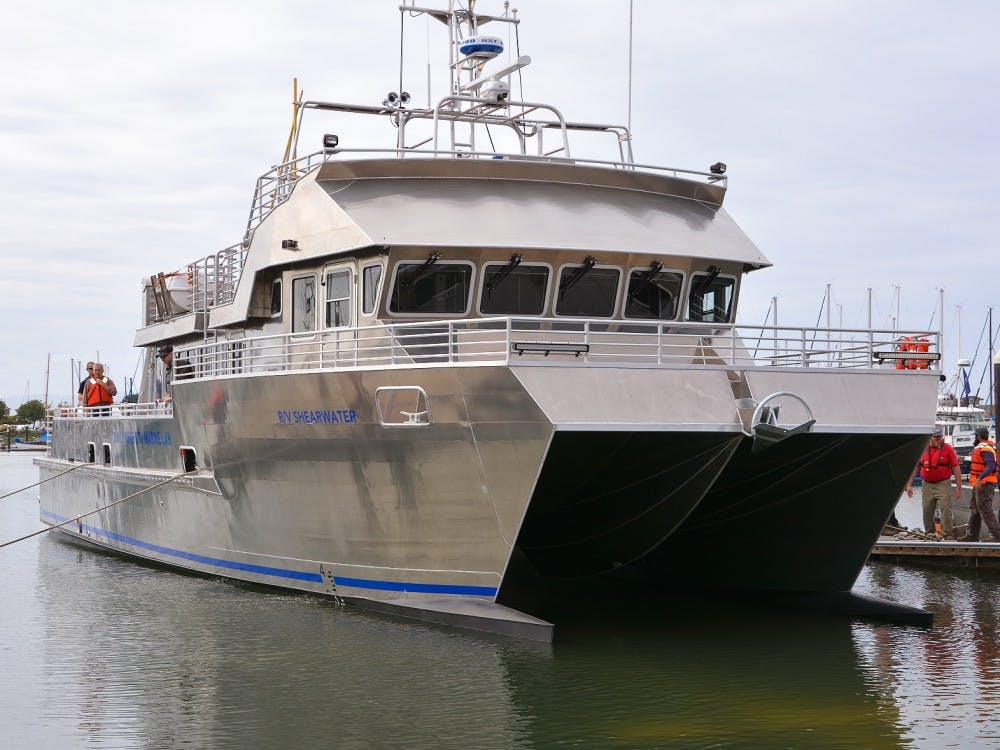Duke’s Marine Lab has oceanographic equipment, coastal waters, marine life—and a brand new 77x 26.6 foot aluminum research vessel.
Since the Marine Lab retired two large vessels in 2013 and 2014, the Marine Lab has relied on smaller boats for daylong trips close to the coast. In 2017, the Marine Lab received a $11 million donor gift to fund the construction and operating costs of a larger boat, according to a news release. The ship will be able to support overnight trips offshore and oceanographic, rather than just coastal, research, explained Katie Wood, assistant director of undergraduate and Marine Lab programs.
To facilitate these overnight trips, the new boat—named the R/V Shearwater—offers sleeping quarters with bunk beds for students. Other features include a dry lab for computes, wet lab for seawater specimens, research instruments and equipment, navigation deck, diving platform and teaching spaces.
Sophomore David Hugo, who is currently studying at the Marine Lab, has used a smaller vessel in his laboratory classes to visit oyster reefs and other research sites.
“In a nutshell, [I study] social science comparing what locals think about species distribution to what’s actually published in data sets,” he said.
Since his research is largely land-based, Hugo has found that the Marine Lab’s smaller boat is well-equipped to serve his team. However, he is still excited about the new vessel’s debut.
“I think it’s going to be very useful for large-scale research,” Hugo said.
The R/V Shearwater is unique compared to the Marine Lab’s past vessels in that it can take advantage of new technologies developed over the last 30 years, said Stephanie Hillsgrove, program coordinator at the Marine Lab.
The new vessel was constructed with a streamlined design and potential environmental impacts in mind. Associate Professor of Oceanography Jim Hench explained that the boat employs the catamaran design, which has two hulls, rather than one, and allows the vessel to be lifted in the water, thus reducing drag. The R/V Shearwater is made of aluminum instead of the traditional steel, he said, making it much lighter and recyclable.
In addition, the vessel utilizes fuel-efficient tier 3 diesel engines, which were the most efficient and least ecologically disruptive engines on the market at the time of design.
“We hoped to make this really an example of what a modern research vessel ought to look like,” Hench said.
However, Hench indicated that the primary goal for the R/V Shearwater was not to develop a piece of truly innovative environmental technology.
“We just wanted something we could put to work right away to work on environmental problems,” he said.
Wood and Hillsgrove said that the boat has not yet reached the Marine Lab and is currently located in Bellingham, Washington. Construction was finished in late September, and the vessel is currently undergoing a series of trials.
The R/V Shearwater is expected to move through the Panama Canal to Florida in January 2020. Wood noted that this will be just in time for the Spring semester, when Zackary Johnson, associate professor of molecular biology in marine science, plans to use the vessel to teach a biological oceanography course in Miami.
Get The Chronicle straight to your inbox
Signup for our weekly newsletter. Cancel at any time.

